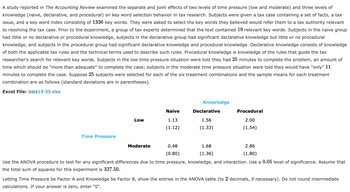
MATLAB: An Introduction with Applications
6th Edition
ISBN: 9781119256830
Author: Amos Gilat
Publisher: John Wiley & Sons Inc
expand_more
expand_more
format_list_bulleted
Question
thumb_up100%
No idea how to do this, the data in the excel file is the same data shown on the screen. any help is appreciated :)

Transcribed Image Text:A study reported in The Accounting Review examined the separate and joint effects of two levels of time pressure (low and moderate) and three levels of
knowledge (naive, declarative, and procedural) on key word selection behavior in tax research. Subjects were given a tax case containing a set of facts, a tax
issue, and a key word index consisting of 1336 key words. They were asked to select the key words they believed would refer them to a tax authority relevant
to resolving the tax case. Prior to the experiment, a group of tax experts determined that the text contained 19 relevant key words. Subjects in the naive group
had little or no declarative or procedural knowledge, subjects in the declarative group had significant declarative knowledge but little or no procedural
knowledge, and subjects in the procedural group had significant declarative knowledge and procedural knowledge. Declarative knowledge consists of knowledge
of both the applicable tax rules and the technical terms used to describe such rules. Procedural knowledge is knowledge of the rules that guide the tax
researcher's search for relevant key words. Subjects in the low time pressure situation were told they had 25 minutes to complete the problem, an amount of
time which should be "more than adequate" to complete the case; subjects in the moderate time pressure situation were told they would have "only" 11
minutes to complete the case. Suppose 25 subjects were selected for each of the six treatment combinations and the sample means for each treatment
combination are as follows (standard deviations are in parentheses).
Excel File: data13-33.xlsx
Time Pressure
Low
Moderate
Naive
1.13
(1.12)
0.48
(0.80)
Knowledge
Declarative
1.56
(1.33)
1.68
(1.36)
Procedural
2.00
(1.54)
2.86
(1.80)
Use the ANOVA procedure to test for any significant differences due to time pressure, knowledge, and interaction. Use a 0.05 level of significance. Assume that
the total sum of squares for this experiment is 327.50.
Letting Time Pressure be Factor A and Knowledge be Factor B, show the entries in the ANOVA table (to 2 decimals, if necessary). Do not round intermediate
calculations. If your answer is zero, enter "0".

Transcribed Image Text:Excel File: data13-33.xlsx
Source of
Variation
Factor A
Factor B
Interaction
Error
Time Pressure
Total
Low
Moderate
327.50
Use the ANOVA procedure to test for any significant differences due to time pressure, knowledge, and interaction. Use a 0.05 level of significance. Assume that
the total sum of squares for this experiment is 327.50.
Letting Time Pressure be Factor A and Knowledge be Factor B, show the entries in the ANOVA table (to 2 decimals, if necessary). Do not round intermediate
calculations. If your answer is zero, enter "0".
Sum
Degrees
of Squares of Freedom Mean Square
Naive
1.13
(1.12)
0.48
(0.80)
F
Knowledge
Declarative
1.56
(1.33)
XX
1.68
(1.36)
Procedural
2.00
(1.54)
p-value
(to 4 decimals)
2.86
(1.80)
XX
Expert Solution
This question has been solved!
Explore an expertly crafted, step-by-step solution for a thorough understanding of key concepts.
This is a popular solution
Trending nowThis is a popular solution!
Step by stepSolved in 7 steps

Knowledge Booster
Similar questions
arrow_back_ios
arrow_forward_ios
Recommended textbooks for you
 MATLAB: An Introduction with ApplicationsStatisticsISBN:9781119256830Author:Amos GilatPublisher:John Wiley & Sons Inc
MATLAB: An Introduction with ApplicationsStatisticsISBN:9781119256830Author:Amos GilatPublisher:John Wiley & Sons Inc Probability and Statistics for Engineering and th...StatisticsISBN:9781305251809Author:Jay L. DevorePublisher:Cengage Learning
Probability and Statistics for Engineering and th...StatisticsISBN:9781305251809Author:Jay L. DevorePublisher:Cengage Learning Statistics for The Behavioral Sciences (MindTap C...StatisticsISBN:9781305504912Author:Frederick J Gravetter, Larry B. WallnauPublisher:Cengage Learning
Statistics for The Behavioral Sciences (MindTap C...StatisticsISBN:9781305504912Author:Frederick J Gravetter, Larry B. WallnauPublisher:Cengage Learning Elementary Statistics: Picturing the World (7th E...StatisticsISBN:9780134683416Author:Ron Larson, Betsy FarberPublisher:PEARSON
Elementary Statistics: Picturing the World (7th E...StatisticsISBN:9780134683416Author:Ron Larson, Betsy FarberPublisher:PEARSON The Basic Practice of StatisticsStatisticsISBN:9781319042578Author:David S. Moore, William I. Notz, Michael A. FlignerPublisher:W. H. Freeman
The Basic Practice of StatisticsStatisticsISBN:9781319042578Author:David S. Moore, William I. Notz, Michael A. FlignerPublisher:W. H. Freeman Introduction to the Practice of StatisticsStatisticsISBN:9781319013387Author:David S. Moore, George P. McCabe, Bruce A. CraigPublisher:W. H. Freeman
Introduction to the Practice of StatisticsStatisticsISBN:9781319013387Author:David S. Moore, George P. McCabe, Bruce A. CraigPublisher:W. H. Freeman

MATLAB: An Introduction with Applications
Statistics
ISBN:9781119256830
Author:Amos Gilat
Publisher:John Wiley & Sons Inc

Probability and Statistics for Engineering and th...
Statistics
ISBN:9781305251809
Author:Jay L. Devore
Publisher:Cengage Learning

Statistics for The Behavioral Sciences (MindTap C...
Statistics
ISBN:9781305504912
Author:Frederick J Gravetter, Larry B. Wallnau
Publisher:Cengage Learning

Elementary Statistics: Picturing the World (7th E...
Statistics
ISBN:9780134683416
Author:Ron Larson, Betsy Farber
Publisher:PEARSON

The Basic Practice of Statistics
Statistics
ISBN:9781319042578
Author:David S. Moore, William I. Notz, Michael A. Fligner
Publisher:W. H. Freeman

Introduction to the Practice of Statistics
Statistics
ISBN:9781319013387
Author:David S. Moore, George P. McCabe, Bruce A. Craig
Publisher:W. H. Freeman